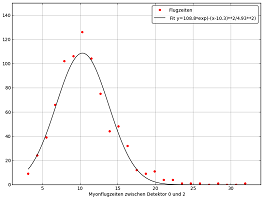URL: https://www.desy.de/school/school_lab/zeuthen_site/cosmic_particles/glossar/index_eng.html
Breadcrumb Navigation
Glossar
G
Gaussian Functions
Gaussian functions are always used to describe normal distributions. They are therefore of particular interest for probability calculations and show the deviation of measured values from the expected value in random surveys. The general form of the density function of a normal distribution is
where is the expected value and is the variance.
The expected value is the product of the amount of times each experiment is performed and the probability that a certain result will occur. The more often the experiment is performed, the closer the expected value is to the average of the results.
The variance is the square of the standard deviation and can be calculated with the following formula: , where x̄ stands for the average value.
Ground Level Enhancement (GLE)
GLEs are sudden, sharp and short-lived increases in the intensity of cosmic radiation measured on the surface of the earth. They are caused by powerful solar flares. They either emit above-average electromagnetic radiation or particle streams with such high density and energy that they are hardly shielded by the Earth's magnetic field. Therefore the radiation intensity on the earth's surface is noticeably affected.
It is important to detect GLEs in time. For example, radio signals can be interrupted or the electronics of satellites can be destroyed, which would lead to a failure of communication systems such as the Global Positioning System (GPS). In general, all electronic systems on earth are vulnerable to interference or damage from solar eruptions causing GLEs. However, the increase in radiation is also dangerous for astronauts and airline staff.
In a diagram showing the rate of cosmic particles over time, a GLE can be recognized by its very steep, sudden rise. The return to the normal level takes only a few minutes to hours. Because of their rarity, GLEs are usually numbered consecutively in science. Since 1950, only about 70 GLEs have been detected mainly by neutron monitors.
A detailed description of GLEs can be found in the paper of
Bieber et.al. . Examples of GLEs measured by neutron monitors can be found on the website of the
neutron monitor data base.



